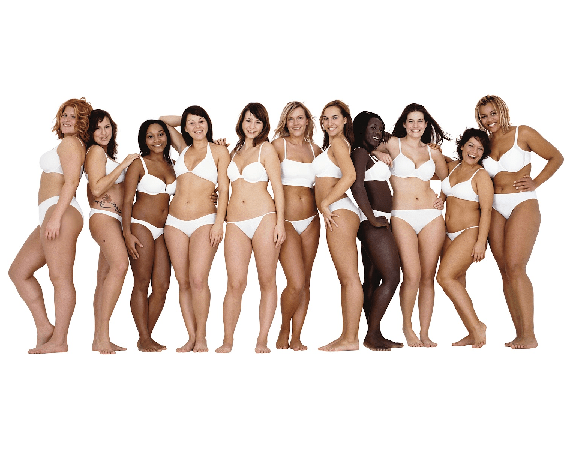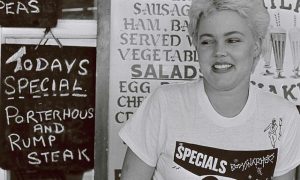The beauty industry is one that has dominated in terms of sales and marketing for decades. It is a field that many are attracted to, yet few take the time to understand how their projected images affect one’s self-image. Though, as many say, “beauty is in the eye of the beholder,” one company realized that beauty lies within all.
In 2004, Dove launched the Campaign for Real Beauty, which was meant to broaden the narrow view of beauty within society.1 Before the release of the Campaign for Real Beauty, Dove attempted to highlight the creamy, moisturizing feel that defined the soap brand by emphasizing the beauty in pampering oneself – oftentimes depicting a beautiful, thin woman, with red lipstick and painted nails. Taking a drastic risk in their marketing strategy, Dove sought to promote a new idea of beauty; they did so by using real women whose looks and weight were far different from the typical model—and it was a smashing success.2 But this success would not have been possible without the creative minds behind the project and the annihilating of what society says beauty should be.

For many decades, the beauty industry has marketed its products with images of the newest, most glamorous, most chic new looks for individuals to try. People love the process of making themselves feel beautiful, and tend to jump at the newest, most popular products to arrive in the market. Specifically, the beauty industry targets women by appealing to the “ideal” image of beauty that is popular at that particular point in time. The most used approach they take is in convincing women that what is most important about them is the way they look. The most common ideal of beauty (especially prevalent since the post-war 1950s) dominant in the minds of many today, is a tall, thin woman who is caked with flawless makeup with silky hair and a straight, white smile. Beauty is not only something that women feed off of, but it has become something people look to to define their own self-confidence. Magazines, games, and social media alike are doused with unrealistic portrayals of beauty. Though there is a high awareness of the impact that media’s idealization of thinness has on women’s health, the industry remains strict to a narrow range of cultural images of attractiveness.3 Before the Dove Campaign for Real Beauty was launched, women, for many years, became used to seeing themselves as being “less-than” that of others. In adapting to change, the beauty industry follows closely the shifting trends of the times. For example, the 1950s was characterized by rolled bangs and winged eyeliner, the 1980s by bold eye shadow and crimped hair, and the 2000s by fake tans and lip gloss.4 In following these trends, women have long adapted to the societal standard of beauty in an attempt to better fit in. These stereotypical views of the ideal woman is what not only feeds the minds of young girls, but it wrecks the body images of millions of women who don’t see themselves as beautiful. In general, the beauty industry tends to feed the minds of many with their own definition of beauty.
One of the key creators and marketing geniuses behind the Campaign for Real Beauty was Joah Santos. As the Chief Creative Officer and founder of NYLON (a multi-platform media company), Santos paved the way for the creative advertising techniques that were used in a multitude of famous ads. Santos became widely known after his making of the P.O.V. (purpose, originality, value) marketing strategy, which was first used to create the Dove Campaign for Real Beauty.5 Within this strategy, he hoped to simplify marketing by giving value to the content of an ad. Content, he explains, gives a story to the brand; the effect of the story is what matters most. There must be a link between a product and the brand’s purpose in order for the technique to make sense. This, in turn, allows the company to build up its credibility.
His focus on evolving a brand based on its story was revolutionary—he set the stage for perhaps the greatest campaign of the twenty-first century. In addition to this, Santos’ ideas led to the Dove Real Beauty Sketches, which was a short film led by Hugo Viega. Viega, a Portuguese copywriter, focused on the concept of risk-taking in his creative, rather than figuring out what would best sell. In his commercial campaign for Dove, Viega hoped to show women that they are more beautiful than they think. To do so, he had various women describe themselves to a sketch artist who could not see them. The sketch artist then drew images of those same women, as described by strangers who had met them the day before. When these images were compared, the stranger’s image was by far more flattering and accurate for every woman who participated. Not only did this video go viral in 2013, but it is said to be one of the most powerful and thought-provoking films Dove has ever released.6 These two men had an enormous role within the Campaign for Real Beauty, with their “test-and-learn” strategy taking them a long way. Ultimately, they sought to express to women that their imperfections do not define who they are. Without them, the campaign would not have grown into what it is today.
The conversation of beauty in today’s society is one that is standardized across the board. The projected images of beauty within media and advertisements alike are what influence the way women see themselves in relation to the rest of the world. These idealized images that are prevalent in advertising are what make consumers feel that they must strive for some unattainable goal of beauty. This, in turn, makes them feel threatened in a way that has a negative effect on their self-esteem.7
Humans in general have a tendency to compare some aspect of the self to that of others, and this is known as social comparison. Social comparisons take place when individuals are heavily influenced by their social environment.8 Projecting ultra-thin models as a beauty ideal comes with its costs. The general conclusion among researchers is that the exposure to thinness-depicting media is related to greater body dissatisfaction, lower body self-esteem, and self-objectification, especially among young girls.9 Social comparison allows one to understand the projected symbols from media, and how they tend to lower women’s self-assurance in society. The advertising industry routinely utilizes the theory to sell beauty products.10 Men, too, are affected by such standards of beauty; seeing such projected attributes in media, men feel as if they cannot reach those standards, ultimately becoming dissatisfied with their own image.11 Societal standards of beauty have been, and will likely always be, a driving factor in the way individuals view themselves.

In 2004, Dove, in conjunction with the Downing Street Group (a research consulting firm), decided to conduct a massive research experiment to verify the hypothesis that women tend to view themselves as less than optimal. For this, leaders of the Campaign for Real Beauty traveled to ten different countries, surveying a total of three thousand women to find out how they felt about their own appearance. In confirmation of Dove’s guess, the research concluded that merely two percent of women define themselves as being beautiful, and only nine percent described themselves as being attractive.12
The Dove Campaign for Real Beauty was one that was groundbreaking, revolutionary, and bold. Dove began as a company creating moisturizing beauty bars, and evolved into one that insists that women be comfortable in their own skin. This campaign not only encouraged confidence, but it widened the narrow view of what is considered “beautiful” by societal standards (i.e. thinness, fair skin, etc.).
Feminism (the advocacy of women’s equality in society) is a concept that is present in the Dove Campaign for Real Beauty. From the 1960s on, women have empowered themselves to advocate for their own definitions of beauty, not allowing a patriarchal society to define them. For too long, women were told to accept their roles in society and live domestic lives as housewives and caretakers. There has been a long effort to include emancipatory ideals in marketing campaigns, most often met with little transformation.13 To put it simply, the fight for all body types, skin tones, and hair types to be expressed equally in media campaigns has been long fought, yet most advertisers stick to stereotype models, lacking diversified representation. Before the 1960s, gender roles were reinforced by mass media and popular culture. However, after WWII, because women made up a large percentage of the postwar labor force, things began to change for women and their roles in society.14 Even in the 1950s, women began to take on new roles in society even as they were encouraged to play traditional roles. These new roles represented the beginning of women breaking away from the conformist ideals of that time period.
In relation to the twenty-first century, women have continued to advocate equality via feminist activism. The Dove Campaign for Real Beauty is a prime example of this, as it pulls away from the commonplace, stereotypical view of women in society today. In using “feminist consumerism,” the Campaign for Real Beauty has the power to disrupt gender norms with its engagement in grassroots activism, as well as in its critiques of the beauty industry.15

In all, the Dove Campaign for Real Beauty is one that has set the stage for groundbreaking change in the minds of women in today’s society. Not only have some beauty companies restructured their use of models and media strategies, but the idea of using “real women” has been popularized. In kicking off a conversation of women’s roles in society’s standards of beauty, the campaign reframed the very idea of female attractiveness. The empowerment of women to be confident in their own skin is what drove this campaign; it not only celebrated the natural beauty of women around the world, but it reinforced the idea that societal standards do not define who you are.
- Encyclopedia of Major Marketing Campaigns, 2007, s.v. “Unilever PLC,” by Jonathan Kolstad and Judson Knight. ↵
- Encyclopedia of Major Marketing Campaigns, 2007, s.v. “Unilever PLC,” by Jonathan Kolstad and Judson Knight. ↵
- Sarah Grogan, Body Image : Understanding Body Dissatisfaction in Men, Women and Children (London: Routledge, 2008), 11-12. ↵
- Fashion, 2015, s.v. “Beauty by the Decade: The Hair and Makeup Trends We Got from Each Era,” by Sarah Harris. ↵
- Revolvy, 2013, s.v. “Dove Real Beauty Sketches.” ↵
- Revolvy, 2013, s.v. “Dove Real Beauty Sketches.” ↵
- Encyclopedia of Gender in Media, 2012, s.v. “Social Comparison Theory,” by Neil Alperstein. ↵
- Encyclopedia of Gender in Media, 2012, s.v. “Social Comparison Theory,” by Neil Alperstein. ↵
- Kimberly Bissell and Amy Rask, “Real women on real beauty: Self-discrepancy, internalisation of the thin ideal, and perceptions of attractiveness and thinness in Dove’s Campaign for Real Beauty,” International Journal Of Advertising 29, no. 4 (November 2010): 644. ↵
- Donnalyn Pompper, Rhetoric of femininity: female body image, media, and gender role stress/conflict (Lanham: Lexington Books, 2017), 15. ↵
- Encyclopedia of Gender in Media, 2012, s.v. “Social Comparison Theory,” by Neil Alperstein. ↵
- Encyclopedia of Major Marketing Campaigns, 2007, s.v. “Unilever PLC,” by Jonathan Kolstad and Judson Knight. ↵
- Josée Johnston and Judith Taylor, “Feminist Consumerism and Fat Activists: A Comparative Study of Grassroots Activism and the Dove Real Beauty Campaign,” Signs 33, no. 4 (2008): 15. ↵
- Khan Academy, 2016, s.v. “Women in the 1950s,” by Michelle Getchell. ↵
- Josée Johnston and Judith Taylor, “Feminist Consumerism and Fat Activists: A Comparative Study of Grassroots Activism and the Dove Real Beauty Campaign,” Signs 33, no. 4 (2008): 941-66. ↵




95 comments
Jose Fernandez
I think this is a great topic for an article because this marketing strategy redefined the way companies advertise their beauty products. I don’t usually care about things related to this topic, but I think this article is very interesting. I really like the idea; it is a very smart marketing strategy and it reflected on their sales and popularity. I think companies nowadays use photoshop and other tools to sell something that doesn’t even exist.
Martina Rodriguez
I love that someone wrote an article about this campaign, The author did a lovely job of depicting the evolving standards of beauty for women. I was very surprised that the two figure heads behind the campaign were two men. I wonder if before them any women had proposed such a campaign but were shot down because of their gender. I loved the examples given for social comparison. The paragraph on was necessary for understanding the fundamentals of the campaign. The examples given from history also really helped support the article
Kaitlyn Killebrew
Most feminism we see today are the extremists on TV that say they are feminism but instead of fighting for equality they fight to be above men, so it’s really wonderful to see them with dove creating a market where they see everyone as beautiful. With social media, movies, and all things of that aspect we are told that we have to look a certain way and as they stated earlier it doesn’t just apply to women. Women are “suppose” to be thin, with a large chest, bright colored lips and their hair maintained while men are suppose to be muscular, tall, and sharp looking hair. It’s not surprising when this article wrote that only two percent of their data reported they think themselves “beautiful” and nine percent thought themselves “attractive” because our views have become obscured. There’s a video on Youtube by buzzfeed that showed the transformation a models pictures go through during editing. One module in particular would talk about walking past her own pictures and not recognizing them as herself. The pictures were the “idea of perfect” and it would make her think about the difference between the “real her” verses the pictures. That’s why I really love the pictures that Dove has been using. The different shapes of women, the when did our idea of beauty become distorted, and grey gorgeous. Beautiful people and not specified to a few physical features, everyone is beautiful.
Bictor Martinez
I never knew when and how the beauty industry began. Dove completely changed the way young girls and millions of women see themselves compared to the model they see in commercials. By putting ideal women for self promotion for a company’s own use, they destroy many other women’s self confidence. The rest of women who do not see themselves as an “ideal women” begin to doubt themselves on their appearances. By putting “real women” on an advertisement for products it helps destroy the view of a women’s beauty by not a “ideal’s women” appearance, but by their own. It helps boost women’s self confidence to see the beauty in themselves.
Christopher Vasquez
I have not been aware that marketers were targeting women who were considered ideal in a particular era. I think it is a great idea that Dove has been trying to broaden the narrow definition of beauty that society holds. I found it interesting that the techniques for conveying a great marketing pitch overlapped with the techniques in writing a story in our Story Craft books. I also remember seeing the add with individuals describing how they thought they looked vs how they actually looked. I thought it was very eye-opening to know that, after re-watching the add by Dove sketch, people think of themselves as less than they are; I was happy to see that their self-perception increased after they learned what others thought of them.
Faten Al Shaibi
This article is interested me to learn more about Dove’s campaign for real beauty, this campaign is amazing to explain the meaning of true beauty, which lies in the conviction of the person himself and his beauty,Where it is difficult to determine beauty by certain standards because it differs each person in their view of the beauty of the other person
Daniela Martinez
I liked how this article highlights the importance of the Dove campaign. The Dove beauty campaign is one that has been a personal favorite of mine and is one worth following over the years. I love how this campaign doesn’t compare women to each other, instead, it celebrates women and their differences. Unlike many campaigns in the beauty industry, Dove was able to represent women of different races, body types, and age in a way that empowers women across the world. This campaign was able to break away from stereotypical beauty campaigns in a way that opened a path for women to gain self-confidence but most importantly reinforced the idea that social standards do not define one’s beauty.
Gabriela Ochoa
love this article it was written in a really engaging way and targets something that is very important in today’s society. My favorite part of this article and the Dove campaign on its own was that a man saw the need to change society standards of how women saw themselves. I liked how you brought up the video of the women describing how they saw themselves and how others some them. Its great to see a company that supports women and wants them to love themselves how they are.
Indhira Mata
Dove’s campaign is often over looked and it’s unfortunate. Dove has always done its best to show love and importance to women all over the world no matter race,body type, size, and any certain looks that are looked down on. They give someone to relate to every woman. Dove has made women realized that their own beauty is denied by themselves and they help to achieve everyone’s goal of self loving. I love how this article has done the same by passing the message along.
Clarissa Gonzalez
The way this article was written was so engaging. I was able to inform myself about the campaign that
Dove participates in, while also being informed about feminism and the people behind it. It flowed surprisingly well and the information really struck a cord within me. Gender studies is always interesting and knowing that woman are being empowered by such a well known brand is truly liberating. Businesses don’t know how much they really have a hold on every day perceptions, and being a positive influence really helps benefit the people who support Dove.